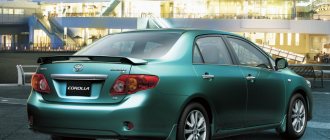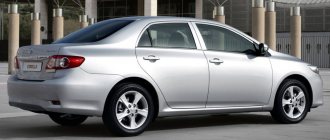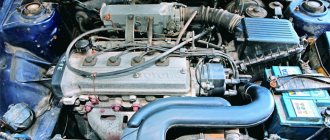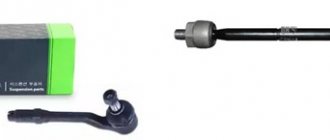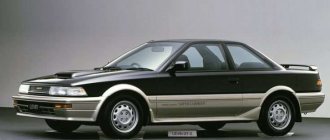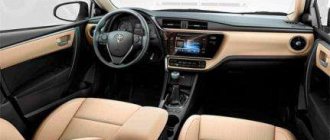In general, today, by the will of fate, I had to ride 250 km. one way and visit the VAZ car showroom. I actually rode a Toyota Corolla (office) 2014. I've driven it before, but this was my first time on a long-distance highway. Brief impressions: I have driven many cars, many Toyotas of different classes, but what is written below is just my opinion.
I'll start with what I like about this car:
1. Torpedo. interesting design, it seems to me in the style of American cars from the 70-80s (I could be wrong) 2. Chassis. Just an excellent adequate suspension. It will be somewhere even better than the Mondeo 4. 3. The plastic interior is quite pleasant. The salon is decorated interestingly. 4. On the highway, you listen to the steering wheel. Doesn't run on ruts. The speed is almost not felt. 5. Adequate consumption at 120 km/h is about 8 liters in winter. 6. I almost forgot. Illumination of the instrument panel and the design of the instrument panel itself. How cozy it turned out.
Now, what I didn't like:
1. The armrest is too high and not comfortable. Of course, you can put your elbow on it, but after a long trip, standing in a traffic jam, there’s no way to lean on it. (I always drive with the seat lowered to the floor.) 2. In a car that costs over a million, they screwed up on the climate control. Dear Toyota people, well, not seriously.
3. There is no cruise control (well, this is already a habit, although based on the cost...) 4. I should have written the first point - the left side of the steering wheel is overloaded with buttons that are not clear how they work. (again, comparison with Ford) and you’ll get used to them. On Ford it’s somehow intuitive. Here, after a day of communicating with the machine, I still did not understand the meaning of all the buttons. There are buttons on the right side of the steering wheel that you hardly use and are also not clear. In general, they went too far here. It needs to be simpler. 5. CVT - the engine hums until the cut-off and the car does not move... The radio system for setting channels, switching music and other settings... in general, it was difficult for me. not intuitively clear. the display is in an inconvenient place.
Now about what was a little misleading.
In general, last winter I took a car around the city and needed to drive it. I’m leaving, driving, and I feel my butt getting hot. I want to turn off the heating, but there are no buttons. Damn, something must have shorted out. But why doesn't it smell? still heated, but where does it turn off?! In short, I couldn’t find it myself. They suggested it. Damn, who thought of putting a heater in an ashtray?
And I don’t understand why a car of this class and this cost can’t be equipped with an auto-closer for ALL windows and not just the driver’s? What kind of principle?
Legendary versus prestige: Corolla (E160, E170) or Octavia III
In general, today, by the will of fate, I had to ride 250 km.
one way and visit the VAZ car showroom. I actually rode a Toyota Corolla (office) 2014. I've driven it before, but this was my first time on a long-distance highway. Brief impressions: I have driven many cars, many Toyotas of different classes, but what is written below is just my opinion. I'll start with what I like about this car:
1. Torpedo. interesting design, it seems to me in the style of American cars from the 70-80s (I could be wrong) 2. Chassis. Just an excellent adequate suspension. It will be somewhere even better than the Mondeo 4. 3. The plastic interior is quite pleasant. The salon is decorated interestingly. 4. On the highway, you listen to the steering wheel. Doesn't run on ruts. The speed is almost not felt. 5. Adequate consumption at 120 km/h is about 8 liters in winter. 6. I almost forgot. Illumination of the instrument panel and the design of the instrument panel itself. How cozy it turned out.
Now, what I didn't like:
1. The armrest is too high and not comfortable. Of course, you can put your elbow on it, but after a long trip, standing in a traffic jam, there’s no way to lean on it. (I always drive with the seat lowered to the floor.) 2. In a car that costs over a million, they screwed up on the climate control. Dear Toyota people, well, not seriously.
3. There is no cruise control (well, this is already a habit, although based on the cost...) 4. I should have written the first point - the left side of the steering wheel is overloaded with buttons that are not clear how they work. (again, comparison with Ford) and you’ll get used to them. On Ford it’s somehow intuitive. Here, after a day of communicating with the machine, I still did not understand the meaning of all the buttons. There are buttons on the right side of the steering wheel that you hardly use and are also not clear. In general, they went too far here. It needs to be simpler. 5. CVT - the engine hums until the cut-off and the car does not move... The radio system for setting channels, switching music and other settings... in general, it was difficult for me. not intuitively clear. the display is in an inconvenient place.
Now about what was a little misleading.
In general, last winter I took a car around the city and needed to drive it. I’m leaving, driving, and I feel my butt getting hot. I want to turn off the heating, but there are no buttons. Damn, something must have shorted out. But why doesn't it smell? still heated, but where does it turn off?! In short, I couldn’t find it myself. They suggested it. Damn, who thought of putting a heater in an ashtray?
And I don’t understand why a car of this class and this cost can’t be equipped with an auto-closer for ALL windows and not just the driver’s? What kind of principle?
Toyota Corolla 2021
From now on, all electric windows are equipped with an automatic mode.
From now on, all electric windows are equipped with an automatic mode.
At first the salon seemed the same. Only after taking a closer look did I realize that it had been seriously redrawn. The instrument panel got rid of radial digitization in favor of a more visual vertical one and acquired a 4.2‑inch color display (previously it was black and white). The screen on the center console has been increased diagonally from 6.1 inches to seven.
Climate control is now controlled by stylish rocker keys, the deflectors at the edges have become round and resemble turbine nozzles. Pleasant little things include a heated steering wheel and automatic mode for all four electric windows.
Over half a century, eleven generations of Corolla have passed, and all of them turned out to be extremely popular. This is the most popular car on the planet!
Tips for choosing Octavia and Corolla
The dimensions of both models are almost identical. Octavia is only 50 mm longer than its competitor and 1 cm higher. The difference in wheelbase is 14 mm in favor of Octavia. The ride height differs by 6 mm: 156 for Octavia and 150 for Corolla.
The third generation Octavia is a good buy if you can separate the taxi cars from the normal cars. The liftback body will cost less than the station wagon. A gasoline engine is more economical than a diesel engine, although the latter will last much longer. Don't look at the DSG: buying this box in good condition second-hand is a godsend. The standard automatic transmission is a good choice, but it comes only with the weak 1.6 engine - the best friend of all taxi drivers in the country. Therefore, the ratio of manual gearboxes with turbocharged 1.4- or 1.8-liter engines will be profitable and successful.
The Toyota Corolla has a poor choice of engines and gearboxes, and the interior is made on a budget. But it will last for many years and travel hundreds of thousands of kilometers. And most importantly, even after 10 years you will be able to resell the car for a high price: the model loses in price only 7% per year. The most profitable combination for purchasing aftermarket is cars after restyling with a 1.6-liter engine with a manual transmission or a regular automatic transmission.
Also read: Japanese cars on the Russian secondary market
Security systems
The list of security systems on the Corolla E170 included:
- Separate brake drive circuit with an ABS unit that distributes forces depending on the load and supports the uphill start and trajectory stabilization systems.
- TRC traction control system, which distributes the power flow between the drive wheels when driving on slippery roads or loose soil.
- Airbags installed in the instrument panel (including the knee element), front seat backrests and body pillars. When installing a child seat, the front passenger's front airbag is switched off manually (there is a control indicator on the instrument panel). Additional Isofix mounts are provided on the rear seat.
- Safety bars located inside the doors (designed to soften side impacts).
- System for forced activation of the hazard warning lights when the speed decreases sharply or when the airbags are deployed.
Exterior, interior and prices
Competitors are like brothers, repeating each other’s outlines and emotions in appearance. The car's features show aggressiveness, dynamics and a unique desire for accomplishment. The salon has complete harmony and aesthetics. The designers of both models paid great attention to the interior, planning the environment to be convenient and comfortable.
If you compare the Lada Vesta in pricing with the Chevrolet Cruze, it turns out that the foreigner is slightly more expensive (575,000 versus 545,000). If the question arises: “What to choose?” — all documented indicators should be compared and focused on one candidate. There is not much difference between them. Chevrolet Cruze, like any “foreigner”, has proven itself well in Russia, Lada Vesta is just beginning to conquer the domestic market.
Car interior
The instrument panel installed in the cabin has a top pad made of foamed plastic with a soft structure. In front of the driver is an analog instrument cluster with a display.
The factory has used a keyless entry system (available on some models), but unlocking sensors are installed only on the front doors. Not all possible options were offered for the Russian market, so the interior has a large number of plastic plugs for buttons or switches.
The radio used in the maximum configuration is equipped with a 7″ diagonal color touch screen; on the side of the display there is a digital clock standard for Corolla.
To control the functions of the multimedia center and on-board computer, buttons located on the steering wheel spokes are used.
Under the radio there is a climate control unit with an additional display and seat heating control buttons. The socket and USB port are located in the pocket in front of the gearbox control knob.
The rear row of seats is equipped with a backrest with an integrated folding armrest, which provides nests for glasses with drinks. The factory kept the body floor behind the front seats flat and the roof slope high, which leaves plenty of headroom for passengers.
An additional socket is provided. Heated or cooled air is supplied to the rear of the cabin through ducts located under the front seats (there are no air ducts on the rear wall of the center console).
A big difference
Despite the apparent proximity and even the use of common technical solutions, there is a real gap between Avensis and Corolla. The mid-size sedan is ahead of the smaller model in many ways, including:
- Dynamics;
- Controllability;
- Space;
- Opportunities in the field of cargo transportation;
- Complete set;
- Economical.
Specifications
| Car model: | Toyota Avensis | Toyota Corolla |
| Manufacturer country: | Japan (Assembled - UK) | Japan (Assembly - Russia) |
| Body type: | Sedan | Sedan |
| Number of places: | 5 | 5 |
| Number of doors: | 4 | 4 |
| Engine capacity, cubic meters cm: | 1598 | 1598 |
| Power, l. s./about. min: | 132/6400 | 122/6000 |
| Maximum speed, km/h: | 200 | 195 |
| Acceleration to 100 km/h, s: | 10,4 | 10,5 |
| Type of drive: | Front | Front |
| Checkpoint: | 5 manual transmission | Variable speed drive |
| Fuel type: | Gasoline A-95 | Gasoline A-95 |
| Consumption per 100 km: | In the city 8.3 / Outside the city 5.4 | In the city 8.2 / Outside the city 5.3 |
| Length, mm: | 4710 | 4620 |
| Width, mm: | 1810 | 1775 |
| Height, mm: | 1480 | 1465 |
| Ground clearance, mm: | 140 | 150 |
| Tire size: | 205/60 R16 | 195/65 R15 |
| Curb weight, kg: | 1435 | 1290 |
| Total weight, kg: | 2050 | 1760 |
| Fuel tank volume: | 60 | 55 |
The only advantage of the Toyota Corolla is its comfort on bad roads, where it can give a head start to many of its competitors. In addition, we must not forget about the cost of the car, which is affordable to many car enthusiasts - in crisis years this is very important. But if money is not the main factor of choice, then preference should be given to the Toyota Avensis, which is a real modern car: dynamic, economical to maintain, safe and easy to drive.
Vehicle handling
The steering is equipped with a rack and pinion mechanism with an electric booster that monitors the speed of movement (as the vehicle accelerates, the gain decreases).
When you turn the steering wheel, the car smoothly changes its trajectory without provoking the driver to take the turn at speed. The soft suspension smooths out uneven road surfaces, but with a sharp change in the trajectory of movement, the body tilts towards the turn.
Passat vs Camry
The two main heartthrobs (or heartbreakers) of business class. Sedans that have held and replaced each other at the top of sales rankings for the last 20 years. What are their features?
- Appearance. There is no comrade to taste or color - this is definitely about our heroes. The Passat is imbued with elegant minimalism, with subtle contours and graceful lines to match its more expensive compatriots. This car is not something special, judging by the photo, but the feeling changes when you see it in person. Toyota is still influenced by Japanese culture with its somewhat cartoonish forms, although it is trying its best to move away from this with each subsequent model. A small nod to Volkswagen - for greater compliance with the category.
- Interior. Someone, finally explain to Toyota designers that wood-look plastic is not cool! The attractive, comfortable and spacious interior suffers from this inexplicable craving of designers for cheap pathos. But again, this is rather “above average”, but not business level. The German car is in a different weight category. High-quality and durable leather, aluminum, incredibly comfortable seats, ergonomics thought out to the smallest detail, a huge trunk - all this is about the Passat.
- Dynamics. For the test we used a Camry with a 2.5 liter engine producing 181 hp. With. and Volkswagen, using a turbocharged 1.8 with 180 horses. The configurations were chosen to balance the machines in terms of cost. And the German car again outperformed its competitor in all respects. The Passat is faster over short and long distances, with less fuel consumption in city mode by as much as 3 liters per 100 km.
- Chassis. After reading the first three points, you may have a fiery desire to throw thoughts about Toyota out of your head and start collecting money for a Passat. But it’s not just that the Camry is the most popular sedan in the CIS, and not its competitor. It's all about Toyota's “omnivorous” suspension, thanks to which it calmly survives on any surface, often without feeling the unevenness of the road. The Passat, on the other hand, uses a traditional rigid suspension that copes flawlessly with maneuvers and turns, but “informs” the driver about every hole on the road. Add here a ground clearance of 145 cm, and it becomes clear why it is not the leader in the CIS market.
Advantages and disadvantages
Main advantages of the car:
- good maneuverability;
- comfortable interior;
- bright light from head optics;
- low fuel consumption;
- the presence of a variator with a modified operating algorithm.
Disadvantages of the car noted by the owners:
- poor factory sound insulation of doors and wheel arches;
- long-term heating of the interior in winter;
- fogging of the upper part of the glass in the doors at air temperatures below -25°C;
- lack of ignition switch illumination;
- ceiling lining, damaged even by soft objects;
- insufficient ground clearance.
What are the advantages of the Toyota Corolla E160
The Corolla is chosen for its good handling, Japanese roots, and good tandem engines and gearboxes. But you will have to pay for this choice with an ascetic and outdated interior and a high price.
The Corolla's trunk is also roomy, but still smaller than its competitor's. If a camp of gypsies fits into the back seat of the Octavia, and their horses fit into the trunk, then the Corolla will only be able to accommodate part of the camp, and even then a smaller one.
The chassis is at the same height as the Octavia's design. The car holds the road well, corners easily, and is pleasantly controlled with a responsive steering wheel. The suspension is comfortable and quietly overcomes road imperfections even at speed.
Under the hood of the Toyota Corolla there are 1.3 petrol units; 1.6 and 1.8 liters with a power of 100-140 hp. With. There are three gearboxes: manual, automatic and variator. The most popular modification was the version with a 1.6-liter engine producing 122 horsepower. The younger engine was not popular at all: it was weak and simply did not pull the sedan along.
All three engines have proven themselves to be reliable and unpretentious; they run 250-300 thousand km to the capital. As in the case of Octavia, the most reliable gearbox was the manual one. For long-term service, it only needs to regularly change the transmission fluid. The Aisin automatic is also reliable, although a little old and slow. By tradition, the CVT is again an outsider. Difficulties in the design lead to difficulties in repair and problems in finding living models on the secondary market.
Also read: The whole truth about the Toyota Prius II hybrid (XW20)
“Corolla” has been at the top of the list in popularity on the used car market for more than a decade. The model is one of the most profitable for the secondary market. Every Toyota car in our country is perceived as the most reliable and practical among all those sold on the market. This stereotype dates back to the 80s and 90s, when this was still true. Nowadays cars are no longer so strong, but they are still falling in price slowly. You won’t be able to buy a Corolla very cheaply, but there will be no problems with maintenance and resale.
Toyota costs more than Skoda. The average price tag for pre-restyling cars is 776 thousand rubles.
Also read: Skoda Octavia A7: pros and cons of the most family-friendly C-class liftback
What changes have been made
Major adjustments introduced during the modernization process:
- changing the design and construction of lighting equipment;
- the use of an improved fuel supply system that does not allow liquid to drain into the tank during long periods of inactivity;
- modification of door frames and reinforcements;
- introduction of new finishing materials;
- use of front fog lights with a modified configuration;
- modification of the wheel rims, which reduced the amount of adhering dirt;
- use of the ERA-GLONASS emergency communication system with an external antenna;
- introduction of a color information display in the instrument cluster;
- expansion of the list of security systems (for example, the plant began to offer a module for monitoring road markings for some markets).
Why is Skoda Octavia III (A7) attractive?
The unconditional advantages of the Octavia are spaciousness in both rows of seats, efficiency in use and maintenance, modernity and comfort. The model also has its drawbacks: driving an Octavia is boring, it is a car not for the soul, but for everyday life. But the main drawback in the secondary market was made by taxi companies. After taxis, according to statistics from avtocod.ru, every third Octavia is sold:
These are damaged, unmaintained and tired cars with huge mileage and low age. To find a suitable copy, you will have to work hard. If you find it, take it without thinking. On average they ask for 700 thousand rubles (versions before restyling).
The car is adequately equipped, it is dynamic, comfortable, roomy, convenient and durable. The Skoda Octavia is good on the move: only cars built on the modular Volkswagen MQB platform grip the road with their teeth and confidently fit even into dashing turns. The chassis is perfectly balanced and the car is a pleasure to drive. The interior is decorated with 50 shades of gray plastic, the ergonomics are excellent - the German roots make themselves felt.
Before the update, the Octavia was offered with 1.2 turbocharged engines; 1.4; 1.8 and 2.0 l. After restyling, the junior 1.2 engine was replaced with a naturally aspirated 1.6 liter. The most popular modification was the 1.4 liter turbocharged version. Two-liter diesel unit with 150 hp. With. - the longest-lasting engine in the Octavia A7 line, but it cannot be called economical. The engine will travel 500-600 thousand km without major repairs if you fill it with good diesel fuel and regularly service the engine. The worst in the line was the 1.6-liter naturally aspirated engine. Firstly, it is too weak for a car. And, secondly, it was he who fell in love with taxi drivers.
There are already four gearboxes in the A7 line: 5- and 6-speed manual, 6-speed automatic and 7-speed DSG. A robotic DSG is not the best choice for an aftermarket car. In general, they are reliable, but it all depends on the operating conditions of the previous owners. If the boxes overheated, then problems cannot be avoided already at 100 thousand km. The standard 6-speed automatic transmission is a suitable option for those who want two pedals instead of three. The most durable Octavia has are manual gearboxes. They are reliable and have no problems, the clutch lasts about 150 thousand km.
Also read: Toyota Vitz II (XP90): All the pros and cons of the city weasel

